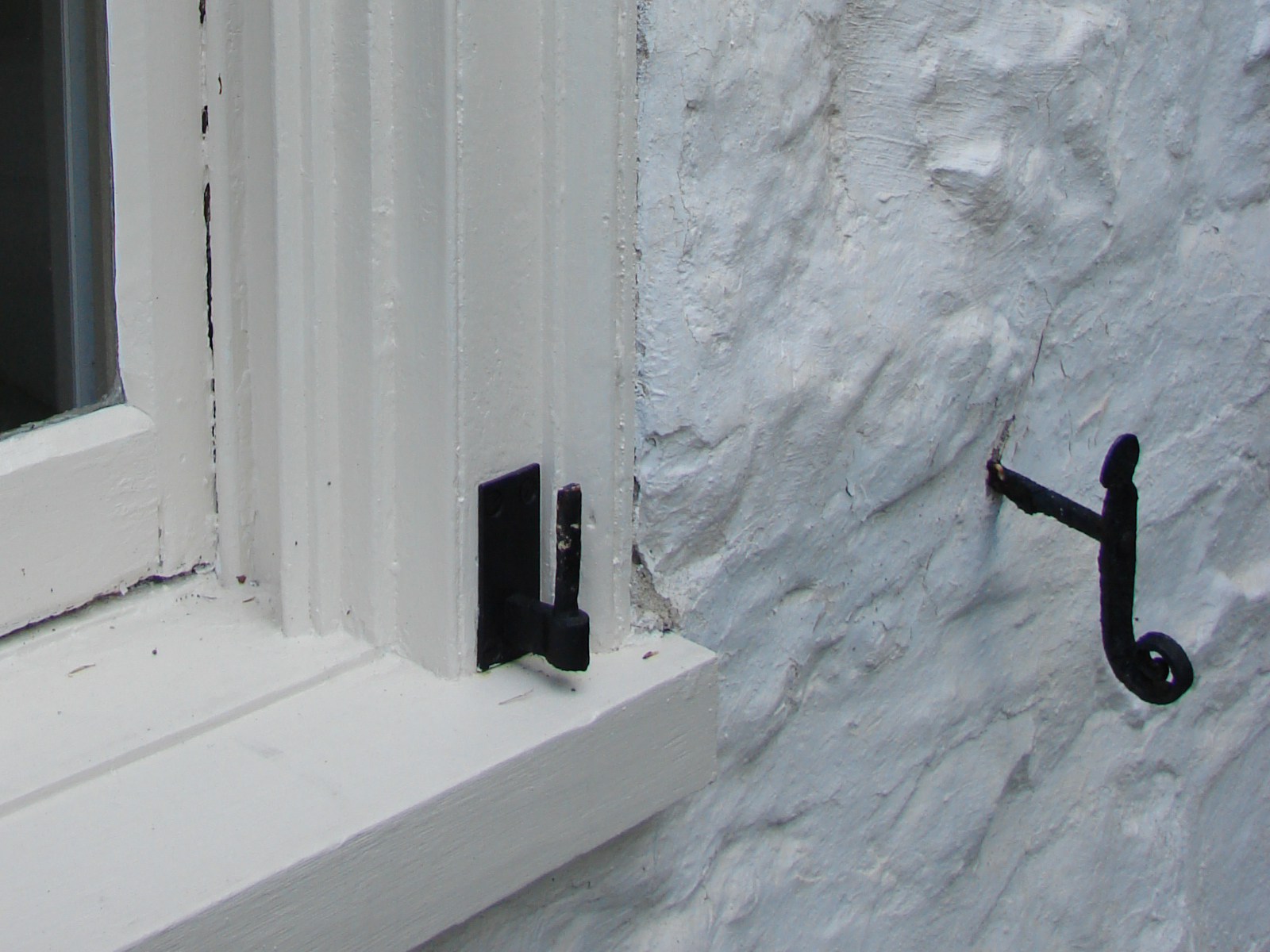
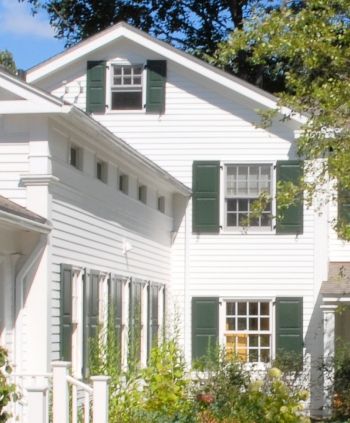
Finding the correct offset for exterior shutter hardware certainly can be daunting. But, with a little practice you’ll be well on your way to hanging your shutters with an offset that’s just right!
What is Hinge Offset and why is it needed?
Hinge Offset is the counterbalance needed for a shutter or door to easily swing open and close, clearing any obstacles such as a deep fitted window frame or trim mouldings. With a larger hinge offset a larger swing (also referred to as “throw”) is created making the shutter protrude, or kick out, further away from the pivot point of the hinge. Knowing which hinge offset you will need is just a matter of finding the amount of throw needed.
Hardware Basics
Hinges are comprised of two parts. 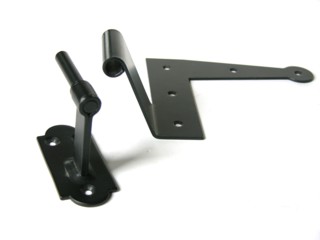
Exterior strap hinges and the “L” type straps (also called “New York style hinges”) shown here on the right consist of a strap and a pintle. In this picture the pintle is on the left and the strap is on the right. The strap mounts to the shutter’s back face and the pintle mounts to the building. Most, if not all shutter and door hinges, are made to be able to separated for installation, as well as general maintenance, hence the term “Lift off Hinge or Loose Pin Hinge”.
Measuring Offsets for Plate Mount Strap Type Hinges
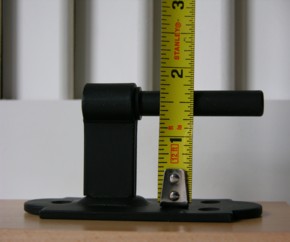
Pintle offset is measured from the base, to the center of the pintle, or pin. When measuring pintle offset sometimes the plate will be included and sometimes not. The measurement will be close enough to measure either way. In this picture I did not incude measuring the plate portion of the pintle that the tape measure is seated on. See how the measurement is one and a half inches ( 1-1/2″ ) to the center of this pintle pin shown to the right?
Measuring the offset on the strap is similar to measuring the pintle offset. Just measure to the center of the knuckle, the hinge joint, less the strap thickness like I did in this picture below.
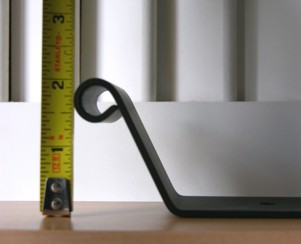
Just remember that you must measure the strap perpendicular to the portion that is mounted on the shutter face and not the angle as I am in the picture above.
Typically the strap offset is matched with the pintle offset. From closest to furthest in the picture shown below are half inch (1/2″), one and a half (1-1/2″) and three and a quarter (3-1/4″) offsets.
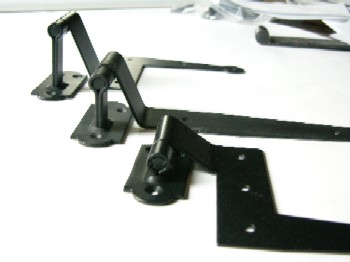
Offsets for Edge Mortise Types
Edge Mortise hinges shown in the picture to the right are also known as butt hinges. Butt hinges consist of two sections or leaves. The pivot pin is located on one of the leaf knuckles. They can be an “H” style (also called a Parliament hinge) as shown or a plain squared version that is our HE1-401 style. Click the picture below for both examples.
For another example of an edge mortise hinge just take a look at your home’s entrance door. See how the hinge leaves are flush with the surface? This is known as hinges that are mortised in. One side of the hinge is mortised flush on the edge of the door and the other half with the pin is mortised flush into the door frame also known as a jamb. It is the same idea for a shutter.
Offsets are measured on an edge mortised butt hinge by taking the distance from the outer edge of the hinge leaf to the center of the pin. You can also just divide the full width of the hinge, both leaves open on a flat surface, and divide by two.
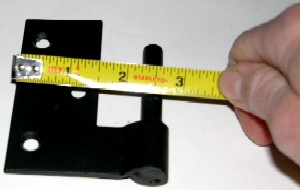
This hinge shown is referenced as a jamb leaf pintle. It’s the same idea for mounting as an edge mortise hinge, mounts to the jamb. The leaf shown has an offset of 2-1/2″ from the outer edge. Sometimes you’ll see offset measured from the inside leaf to the center of the pin. In this picture you can see that would be about 1″ from the inside leaf edge to the center of the pin. If you are going to use this type hinge or even the edge mortise types you need to make sure that the jamb is wide enough for the leaf plate to be securely screwed down.
Whether it is a strap hinge or a butt hinge the pin portion is mounted to the frame. In some cases this will be reversed for strap shutter or gate hardware if the pin is made to be on the straps knuckle. This feature is true of many hinges found on Old Philadelphia Federal Shutters. Regardless of where the pin is located the offset rules will still apply.
How to find your offset

Minimum hinge throw required
The distance from where the hinge will mount to the house to front face of the trim or casing that protrudes out the furthest from your home’s façade is the minimum throw required. This is shown in figure 2 below. If there is no trim or casing, as in many brick and stone homes as shown here to the right and at the beginning of this article, then the minimum hinge throw required will be the distance from where the pintle mounts on the frame to the façade.
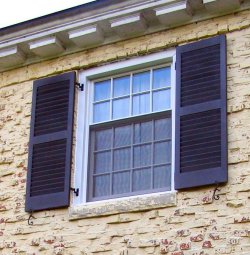
Using what you now know about hinge offsets take a look at this picture-
Do you see the pintle’s large offset, the projection out from the window frame? Along with the matched offset on the “L” strap hinge the shutter now has adequate “throw” kicking it far enough away from the exterior wall. This is the key to knowing which offset to use- just find your throw.

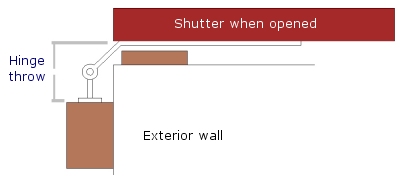
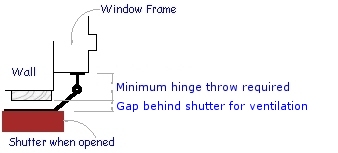
A ½” – 1-1/2” ventilation space is recommended between façade and shutter.
Along with the minimum throw you’ll need to add enough offset to include an area for a ventilation space, a gap, behind the shutters when they are open and tied back against the wall with shutter dogs. This will help the wood ventilate so they do not retain moisture. It will also help ventilate the house wall too. There is no rule for how much ventilation space is required but it typically ranges from about a half to one and a half inches when the shutters are held open with tiebacks.
The following charts show some common offsets that we offer and their throw.
Table A – Use this chart for when the pintle offset equals the strap offset:
| Hinge Offset | Hinge Throw | Minimum Hinge Throw Required |
| 1/2″ | 1″ | 0″ to 1/2″ |
| 1.1/2″ | 3″ | 0″ to 2.1/2″ |
| 2.1/4″ | 4.1/2″ | 0″ to 4″ |
| 3.1/4″ | 6.1/2″ | 0″ to 6″ |
Table B
Some of the hinges that we sell can have split offsets. You might need a large pintle projection from the house and a smaller offset on the shutter hinge. Use this chart for when the pintle offset does not equal the strap offset
| Pintle Offset | Strap Offset | Hinge Throw | Minimum Hinge Throw Required |
| 1″ | 0″ | 1″ | 0″ to 1/2″ |
| 1″ | 1″ | 2″ | 0″ to 1.1/2″ |
| 1″ | 2″ | 3″ | 0″ to 2.1/2″ |
| 2″ | 0″ | 2″ | 0″ to 1.1/2″ |
| 2″ | 1″ | 3″ | 0″ to 1.1/2″ |
| 2″ | 2″ | 4″ | 0″ to 2.1/2″ |
Every window can be different…
Are you still not sure which shutter hinge to use?
Below are a some helpful paper cut out worksheets that you can print out. These templates can be helpful to place where your new shutter hardware will be installed to make sure that you will have adequate offset.
Your printer defaults should be fine for these worksheets to print to scale but if the measurements are incorrect just make sure that your printer is set to a a one to one (1:1) ratio in order for the cut-out templates to work.
![]()
Click & Print:

A naturally beautiful and renewable choice – Wood shutters and doors by
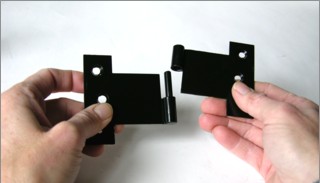


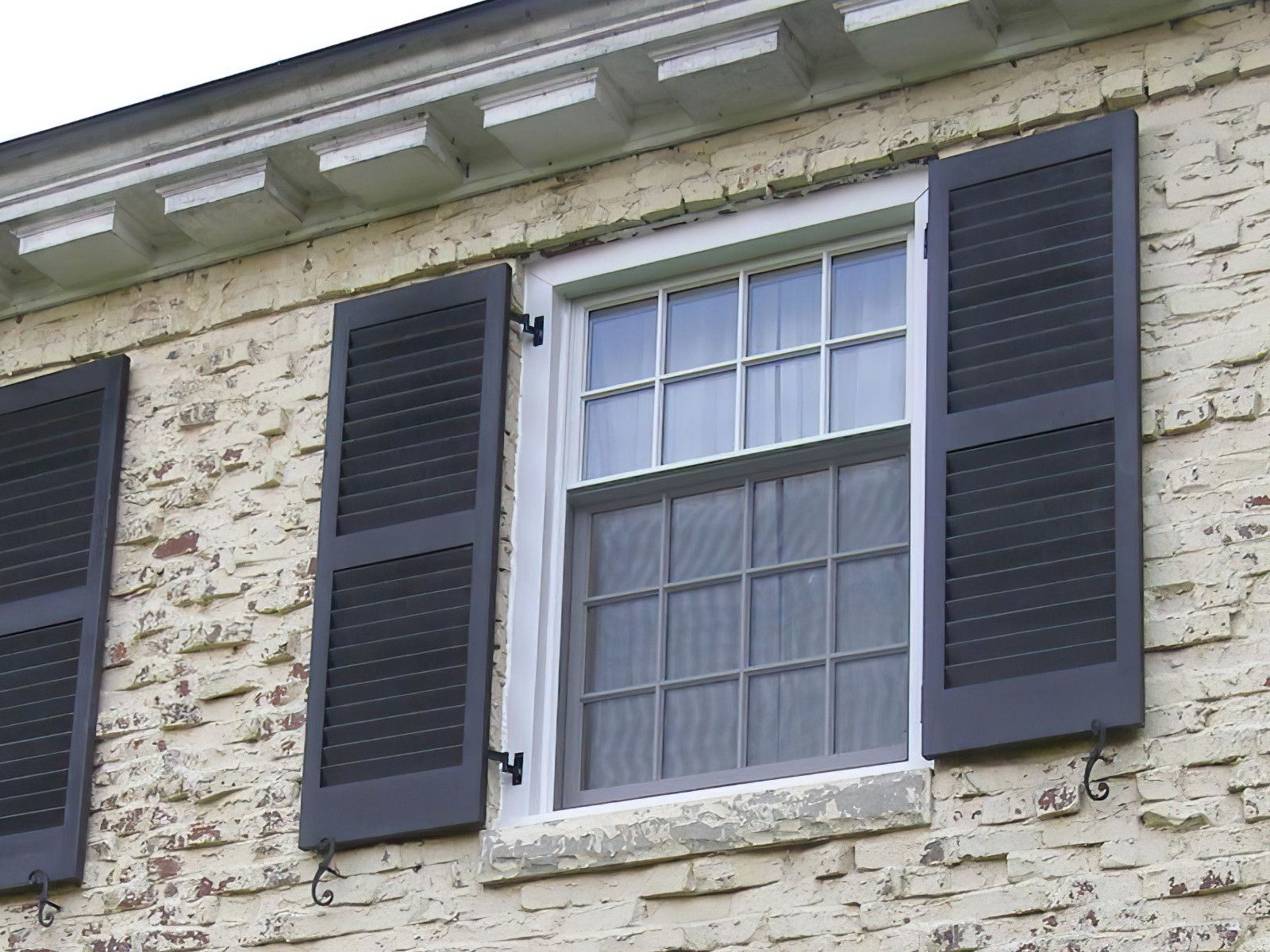
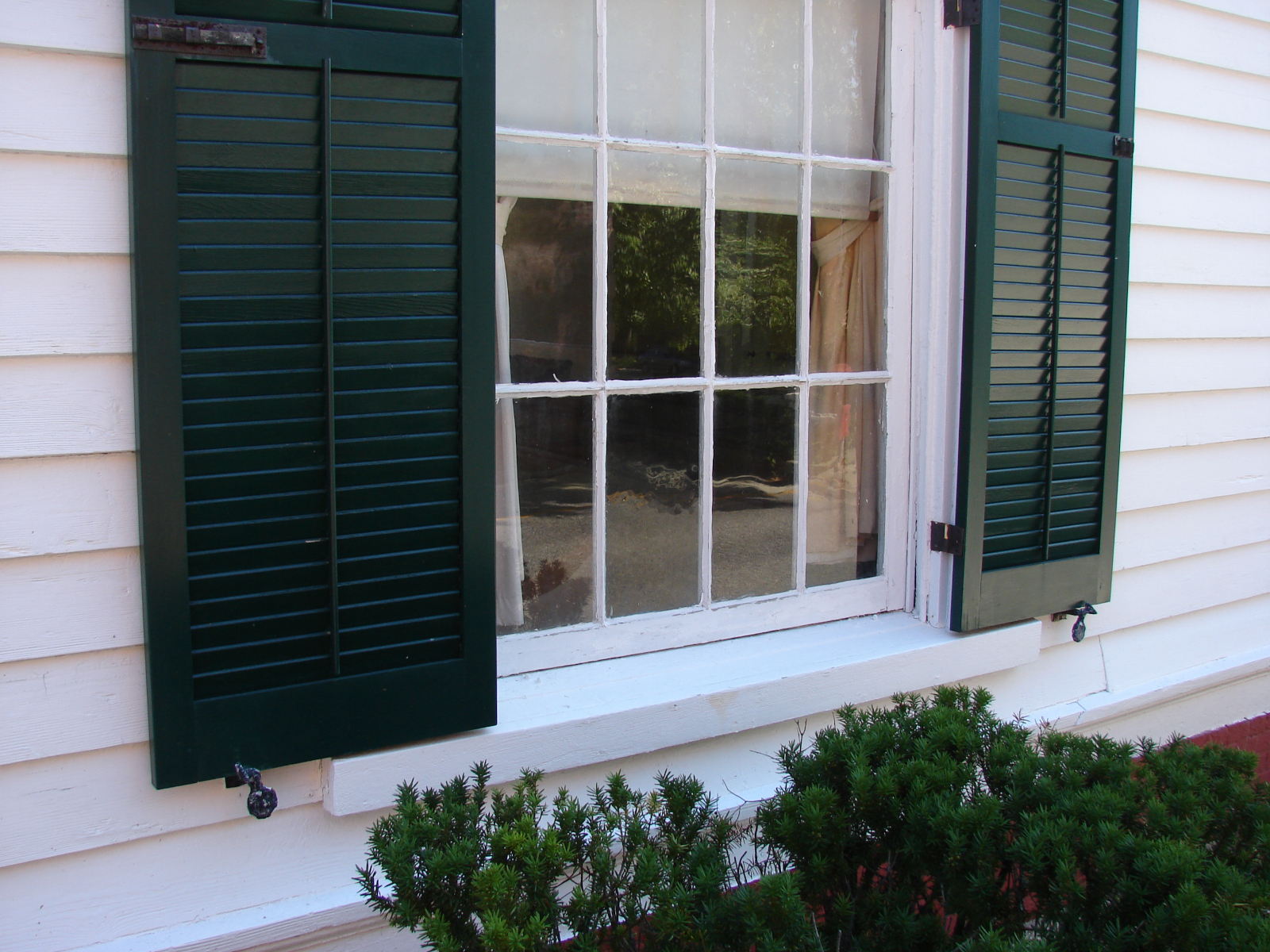
what an informative site. it was very clear and helpful. all the required information was presented so it was understandable. thanks
Hello and thank you for letting us know this post is helpful. -Jewel
It seems to me that there is another dimension that needs to be considered……While you have called the total offset “throw”. I have seen the term “throw” used to mean the distance from the hinge pintle to the shutter edge when shutter is fully closed. or open (edge closest and parallel to pintle).
I have a situation where I need to consider this dimension.
Thank you and sorry if this is not helpful.
Hi Mike,
One of the biggest issues we tend to face is the English language. The same word means different things to different people in different parts of the country.
Technically the “offset” refers to the distance from the pin to the face of the shutter while the “throw” refers to the distance the shutter travels from closed to open position.
Because of this we try not to use the words “offset” and “throw” together.
If you can send us a photo or sketch of your windows I can help you with choosing the correct hinge and offset.
I hope this helps!
Jim
1. The recess is 3/4″, the (exterior) wooden shutters will be 1.5″ thick – therefore they will sit proud by 3/4″ when shut. If I use a 3/4″ pintle I would need a flush hinge but the only ones I’ve seen have an offset. Can I buy a flush (zero offset) removable strap hinge with a 3/4″ pintle to mount on my plastic/vinyl composite wall?
2. Where can I find a guide as to what length hinges, and how many, I should be using for various sized shutters? My first 2 pairs are the largest (and therefore heaviest), at 78.5″ high x 35″ window opening (ie per pair). Do I need 2 hinges or three – or does it depend on hinge size?
Hi Phil,
While 3/4″ is not standard for an offset the black smiths we use can make that. Alternatively you can use a lag bolt pintle which has an adjustable offset. The problem, however, might be in attaching it to your wall. You wrote that it is a plastic/vinyl composite. Do you know if it will hold screws for attaching hardware? I have come across some types that break apart from the threaded fastener and meant to only be used with nails and staples.
As far as the number of hinges you need it does depend on the type of hinge as well as the size. For strap hinges (“L” hinges and straight straps) that are made from hammered iron or plate steel 2 hinges would be sufficient per shutter. They are strong enough, and flexible enough, to support those weights. If you decided to go with cast iron hinges you should go with 3 hinges per shutter. Cast iron hinges are not flexible and can break if too much torque is applied. Having a 3rd cast iron hinge helps prevent this.
I hope this helps.
Jim
Hi Jim. I am trying to replace my shutter hinges but I don’t know what these Are called. Can you help me? I can’t seem to send an email in this form but if you email me, I can email a picture.
Hi Amy. Sorry about not being able to send an email. An update was done on our blog and some features were accidentally deactivated. I will send you an email. Typically we ask people to send pictures of hardware they are looking to replace. Ideally a close up of the hardware piece as well as a photo of the overall window with the shutters and hardware.
Please send me an email and I will send drawing of my window. I’m completely confused as to what size pintle, strap, hinge….whatever. I just know that I love the look of real working shutters, even if I never close them. Heeeellllppppp!
Hi Glinda, did you receive my email?
HI Jim,
I found your posting the MOST helpful on the web for how to measure for hinges and pintles. Thank you!! I have a question regarding determining offset and what to purchase.
If the measurement from my window frame (where I intend to mount the pintle) to the exterior brick surface of the house is 3.5 inches deep, do I add that distance (3.5 inches) to the total ventilation depth (say 1 inch) to = 4.5 inches and then divide that by 2 to assume my offset on both the pintle and hinge that I should purchase are both 2.25 inches?
Thank you advance for your help!
Hi Soula,
If I am understanding you correctly, then I would agree with your math. However, I would have a number of follow up questions that would be dependent on seeing a photo of your installation. If you can, please email a photo of one of your windows to sales@diyshutters.com. Also, will the shutters be fully functional, or decorative only but meant to look functional?
Jim
Jim,
I have a block/stucco home in Florida. The windows are very recessed in the openings. I am thinking of mounting the operational shutters so they cover the entire opening and a few inches all around. What kind of strap hinge offset should I use if the shutters are 1” thick?
Thanks
Mike
Hi Mike,
When you are mounting into stucco you will want to use a lag bolt pintle, which is available with most any of our strap hinges. The lag bolt can then be threaded into the side of your house to achieve the offset you want.
Normally the shutter sits flush with the face of the wall around the window, and the offset of the hinge and pintle are the same. When the shutter is going to sit proud of the opening you end up with the pintle and hinge offset being different by the thickness of the shutter.
Since the offset for the lag bolt pintle is adjustable you can use a strap hinge with no offset, or a slight 3/4″ offset. For ordering a combination like this it is a bit easier to call or email so we can make sure to put together the right hardware for your shutters.
Thanks! Jim
Hi Jim!
My situation –
Looking to mount operable board/batten shutters that will open over a stone foundation. Windows are (nominally) recessed 6″ +/- inside of the finished stone veneer. As one might expect, the stone is not perfectly flat. In spots it might protrude to 6-1/2″-7″ proud of the “3-1/4″ offset pintle” mount location to the face of the brick moulding. Using a “3-1/4″ offset hinge” I might get by with the combined 6-1/2″ “throw”, but my concern is that the pintle mount will be fastened to 1-3/4″-2″ wide (max) window brick molding and the roughly 19 deg. angle shown on the 3-1/4″ strap hinge likely won’t allow for the shutter to fully open before striking the vertical plumb line of the stone veneer thus leaving it in a partial open position. Is there a remedy? I can send images.
Hello Marcel,
Pictures would be helpful. Please send them to sales@diyshutters.com
We’ve run into stone installations before where the stone was rather uneven. For one historic site the combination of the 200+ age of the building and the uneven stone/stucco meant that we had to go with custom offset pintles that differed for each window.
I’m not sure how thick the 1.3/4″-2″ wide mounting frame is, but an oversize lag bolt pintle might work for you. Then you could turn in/out each pintle to achieve the offset that you need.
For now, pictures would be a great place to start.
Thanks!
Jim